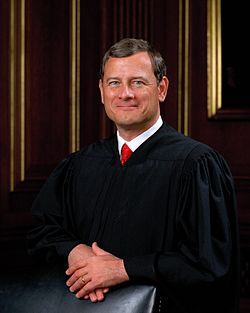| Chief Justice of the United States | |
|---|---|
 Seal of the Supreme Court | |
| Supreme Court of the United States | |
| Style | Mr. Chief Justice (informal) Your Honor (within court) The Honorable (formal) |
| Status | Chief justice |
| Member of | Federal judiciary Judicial Conference Administrative Office of the Courts |
| Seat | Supreme Court Building, Washington, D.C. |
| Appointer | The president with Senate advice and consent |
| Term length | Life tenure |
| Constituting instrument | Constitution of the United States |
| Formation | March 4, 1789 |
| First holder | John Jay |
| Salary | $312,200 USD |
| Website | SupremeCourt.gov |
| This article is part of a series on the |
| Supreme Court of the United States |
|---|
 |
| The Court |
| Current membership |
|
| Lists of justices |
|
| Court functionaries |
The chief justice of the United States is the chief judge of the Supreme Court of the United States and is the highest-ranking officer of the U.S. federal judiciary. Article II, Section 2, Clause 2 of the U.S. Constitution grants plenary power to the president of the United States to nominate, and, with the advice and consent of the United States Senate, appoint "Judges of the Supreme Court", who serve until they die, resign, retire, or are impeached and convicted. The existence of a chief justice is only explicit in Article I, Section 3, Clause 6 which states that the chief justice shall preside over the impeachment trial of the president; this has occurred three times, for Andrew Johnson, Bill Clinton, and for Donald Trump's first impeachment.
Contents
- Origin, title and appointment
- Powers and duties
- Impeachment trials
- Seniority
- Presidential oath
- Other duties
- Disability or vacancy
- List of chief justices
- Notes
- References
- Further reading
- External links
The chief justice has significant influence in the selection of cases for review, presides when oral arguments are held, and leads the discussion of cases among the justices. Additionally, when the court renders an opinion, the chief justice, if in the majority, chooses who writes the court's opinion; however, when deciding a case, the chief justice's vote counts no more than that of any other justice.
While nowhere mandated, the presidential oath of office is by tradition administered by the chief justice. The chief justice serves as a spokesperson for the federal government's judicial branch and acts as a chief administrative officer for the federal courts. The chief justice presides over the Judicial Conference and, in that capacity, appoints the director and deputy director of the Administrative Office. The chief justice is an ex officio member of the Board of Regents of the Smithsonian Institution and, by custom, is elected chancellor of the board.
Since the Supreme Court was established in 1789, 17 people have served as Chief Justice, beginning with John Jay (1789–1795). The current chief justice is John Roberts (since 2005). Five of the 17 chief justices—John Rutledge, Edward Douglass White, Charles Evans Hughes, Harlan Fiske Stone, and William Rehnquist—served as associate justices prior to becoming chief justice. Additionally, Chief Justice William Howard Taft had previously served as president of the United States.



















